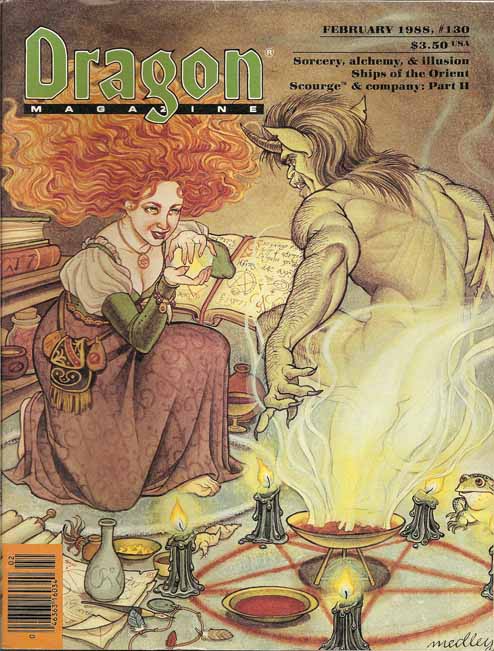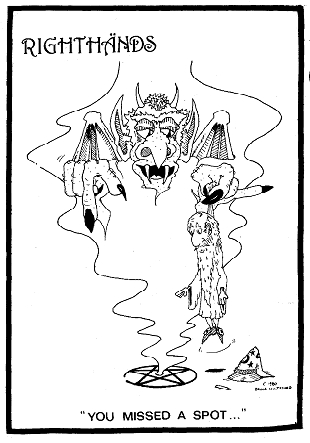Ensnarement
(Conjuration/Summoning)

Ensnarement
(Conjuration/Summoning)

|
|
|
|
|
|
|
|
|
|
|
|
|
|
|
|
|
|
Effect: The casting
of this spell attempts a dangerous act --
the luring of a powerful
creature from another plane to a specially prepared trap where it will
be held until it agrees to perform one service in return for freedom from
the ensnarement spell.
The spell causes an awareness
of a gate-like opening <in the dimension> of the creature to
be ensnared.
A special save is then made
to determine if the creature detects the nature of the planar opening as
a trap or believes it to be a gate.
To save, the creature must
roll equal to or less than its intelligence on 3d6.
The score is modified by
the difference between the creature's intelligence and that of the spell
caster's.
If the creature has a higher
score, the difference is subtracted from its dice roll to save.
If the spell caster has
a higher score, the difference is added to the total of the 3d6.
If the save succeeds,
the creature merely ignores
the spell-created opening,
and the dweomer fails.
If the saving throw is not
made,
the creature steps into
the opening and is ensnared.
The type of creature to
be ensnared must be known and stated,
and if it has a specific,
proper, or given name,
this also must be used in
casting of the ensnarement spell.
When actually ensnared,
the creature coming from
another plane to that of the spell caster is not constrained from harming
the one who trapped it.
Therefore, the caster uses
a magic circle (for creatures from the upper planes or the Astral Plane),
a thaumaturgic triangle
(for creatures from the Ethereal, Elemental, or Concordant Opposition planes),
or a pentagram (for creatures
of the lower and infernal planes).
Regardless of such protection,
there is a chance that the
entrapped creature will be able to break free and wreak its vengeance upon
the spell caster.
The base chance for an ensnared
creature to break free depends on the manner in which the confining design
was made.
A hand-done
one has a base 20% chance of being broken,
one inlaid
or carved has only a base of 10%,
and that
for the first time only (which indicates whether or not the job was done
properly).
This base chance is modified
by the total score of the magic-user's combined intelligence and experience
level compared to the intelligence score and the experience level or number
of hit dice of the creature summoned.
If the spell caster has
a higher total,
that
difference is subtracted from the percentage chance for the creature to
break free.
If the creature has a higher
total,
that
difference is added to its chance to break free.
The chance may be further modified by care in the preparation of the protective symbol.
If the hand-made
protection is inscribed over a long period of time,
using specially prepared
pigments (1,000 gp per turn of application),
the chance of an ensnared
creature breaking free is reduced by 1% for every turn spent so preparing;
i.e.,
an expenditure of 1 turn and 1,000 gp reduces the chance of breaking free
by 1%.
This can bring the base
chance to 0%,
but the further modifications
for intelligence and experience level must be made thereafter,
and no amount of special
preparation can negate that risk.
Similarly, an inlaid
or inscribed design can be brought to a 0% chance of being broken
by inlaying it with various metals, minerals, etc.
This effort will require
a minimum of one full month of time and add not less than 50,000 gp to
the basic cost of having the protection inlaid or inscribed into stone.
Any breaking of the lines
of protection or blurring of the glyphs, runes, and sigils which guard
the magical barrier will spoil the efficacy of the dweomer and allow the
creature to break free automatically.
Even a straw dropped across
the lines of a circle destroy its power.
Fortunately, the creature
within cannot so much as place a straw upon any portion of the inscribed
protective device,
for the magic of the barrier
absolutely prevents it.
Once safely ensnared,
the creature can be kept
for as long as the spell caster dares.
(Remember the danger of
something breaking the inscription!)
The caster can offer bribes,
use promises, or make threats in order to exact one service from the captive
creature.
The DM will then assign
a value to what the magic-user has said to the ensnared creature,
rating it from 0 to 6.
This rating is then subtracted
from the intelligence score of the creature.
If the creature makes its
saving throw,
a score equal to or less
than it's adjusted intelligence,
it will refuse service.
New offers, bribes, etc.
can be made,
or the old ones re-offered
24 hours later,
when the creature's intelligence
has dropped by 1 point to due confinement.
This can be repeated until
the creature promises to serve,
until it breaks free,
or until the caster decides
to release it by means of some riddance spell.
It need not be stressed
that certain spells can be used to force a captive creature into submission.
Once the single service is
completed,
the creature need only so
inform the spell caster to be instantly teleported from whence it came.
Revenge can be sought (cf.
efreeti, aerial servant, and invisible stalker). <make links to targets
on those pages>
Impossible demands or unreasonable
commands will never be agreed to.
Q: Can a creature
such as a demon
that is captured by an ensnarement
spell use its innate teleportation
abilities to escape? Can
it use gate to
summon help? Can it do anything
to
escape?
A: The ensnarement
spell neither strips the
victim of attack abilities
nor protects the
caster from them. An ensnared
creature
could launch missiles or
attempt ranged
magical attacks, but such
attacks will
never damage the diagram
that holds the
creature. The creature could
charm the
caster into letting it go.
The caster, however,
is free to employ other
protective
spells which will work normally
with
regard to the ensnared creature.
An antimagic
shell is most effective
for this purpose.
The ensnared creature is
trapped by
the spell until the caster
chooses to let it
go, or some other creature
releases it ?
either on purpose or by
accident. The
creature is totally cut
off from its own
plane, and it cannot summon
aid (e.g.,
gate) or escape from the
diagram by any
means (e.g., teleportation)
except by
attacking or serving the
caster. Demons
are extremely difficult
to hold with this
spell due to their telekinesis
abilities. Any
spell-caster who fails to
guard against such
powers will most likely
be dragged into
the diagram and suffer accordingly.
(133.72)
<added shading>
<perhaps, add jpgs, and/or
links to the various protective devices>
